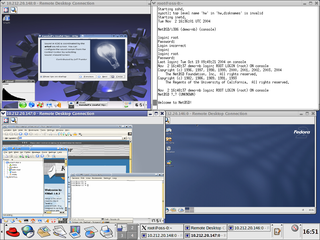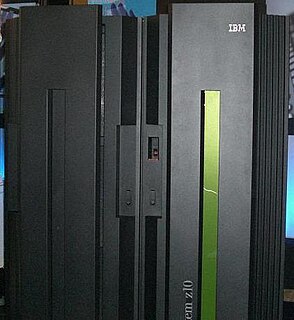Related Research Articles
IBM mainframes are large computer systems produced by IBM since 1952. During the 1960s and 1970s, IBM dominated the large computer market. Current mainframe computers in IBM's line of business computers are developments of the basic design of the IBM System/360.

Solaris is a proprietary Unix operating system originally developed by Sun Microsystems. After the Sun acquisition by Oracle in 2010, it was renamed Oracle Solaris.

Hercules is a computer emulator allowing software written for IBM mainframe computers and for plug compatible mainframes to run on other types of computer hardware, notably on low-cost personal computers. Development started in 1999 by Roger Bowler, a mainframe systems programmer.

VM is a family of IBM virtual machine operating systems used on IBM mainframes System/370, System/390, zSeries, System z and compatible systems, including the Hercules emulator for personal computers.

Xen is a type-1 hypervisor, providing services that allow multiple computer operating systems to execute on the same computer hardware concurrently. It was originally developed by the University of Cambridge Computer Laboratory and is now being developed by the Linux Foundation with support from Intel, Citrix, Arm Ltd, Huawei, AWS, Alibaba Cloud, AMD, Bitdefender and epam.
These tables provide a comparison of operating systems, of computer devices, as listing general and technical information for a number of widely used and currently available PC or handheld operating systems. The article "Usage share of operating systems" provides a broader, and more general, comparison of operating systems that includes servers, mainframes and supercomputers.
The Integrated Facility for Linux (IFL) is an IBM mainframe and Power Systems processor dedicated to running the Linux operating system. On IBM Z and IBM LinuxONE machines, IFLs can be used with or without hypervisors such as z/VM and KVM. IFLs are one of three most common types of "specialty" IBM mainframe processors that give software vendors more granular control over software licensing and maintenance costs.. Microcode restricts IFLs to Linux workload by omitting some processor instructions not used by the Linux kernel, but the underlying processors are physically identical to general purpose processors (CPs). When IBM adds features and performance improvements to its mainframes' general purpose main processors, those features and improvements nearly always apply equally to IFLs. In fact, in recent IBM Z machines IFLs support simultaneous multithreading, a feature not available for general purpose processors.
A hypervisor is similar to an emulator; it is computer software, firmware or hardware that creates and runs virtual machines. A computer on which a hypervisor runs one or more virtual machines is called a host machine, and each virtual machine is called a guest machine. The hypervisor presents the guest operating systems with a virtual operating platform and manages the execution of the guest operating systems. Multiple instances of a variety of operating systems may share the virtualized hardware resources: for example, Linux, Windows, and macOS instances can all run on a single physical x86 machine. This contrasts with operating-system–level virtualization, where all instances must share a single kernel, though the guest operating systems can differ in user space, such as different Linux distributions with the same kernel.
Since the rise of the personal computer in the 1980s, IBM and other vendors have created PC-based IBM-compatible mainframes which are compatible with the larger IBM mainframe computers. For a period of time PC-based mainframe-compatible systems had a lower price and did not require as much electricity or floor space. However, they sacrificed performance and were not as dependable as mainframe-class hardware. These products have been popular with mainframe developers, in education and training settings, for very small companies with non-critical processing, and in certain disaster relief roles.

IBM Z is a family name used by IBM for all of its z/Architecture mainframe computers.
Basic Assembly Language (BAL) is the commonly used term for a low-level programming language used on IBM System/360 and successor mainframes. Originally, "Basic Assembly Language" applied only to an extremely restricted dialect designed to run under control of IBM Basic Programming Support (BPS/360) on systems with only 8 KB of main memory, and only a card reader, a card punch, and a printer for input/output — thus the word "Basic". However, the full name and the initialism "BAL" almost immediately attached themselves in popular use to all assembly-language dialects on the System/360 and its descendants. BAL for BPS/360 was introduced with the System/360 in 1964.
The following is a timeline of virtualization development. In computing, virtualization is the use of a computer to simulate another computer. Through virtualization, a host simulates a guest by exposing virtual hardware devices, which may be done through software or by allowing access to a physical device connected to the machine.

Oracle VM VirtualBox is a type-2 hypervisor for x86 virtualization developed by Oracle Corporation.

IBM System z10 is a line of IBM mainframes. The z10 Enterprise Class (EC) was announced on February 26, 2008. On October 21, 2008, IBM announced the z10 Business Class (BC), a scaled-down version of the z10 EC. The System z10 represents the first model family powered by the z10 quad core processing engine. Its successors are the zEnterprise System models introduced in 2010 and 2012.
The Java Development Kit (JDK) is a distribution of Java Technology by Oracle Corporation. It implements the Java Language Specification (JLS) and the Java Virtual Machine Specification (JVMS) and provides the Standard Edition (SE) of the Java Application Programming Interface (API). It is derivative of the community driven OpenJDK which Oracle steward. It provides software for working with Java applications. Examples of included software are the virtual machine, a compiler, performance monitoring tools, a debugger, and other utilities that Oracle considers useful for a Java programmer.

Linux on IBM Z is the collective term for the Linux operating system compiled to run on IBM mainframes, especially IBM Z and IBM LinuxONE servers. Similar terms which imply the same meaning are Linux on zEnterprise, Linux on zSeries, Linux/390, Linux/390x, etc. The three Linux distributions certified for usage on the IBM Z hardware platform are Red Hat Enterprise Linux, SUSE Linux Enterprise, and Ubuntu.
In computing, a system virtual machine is a virtual machine that provides a complete system platform and supports the execution of a complete operating system (OS). These usually emulate an existing architecture, and are built with the purpose of either providing a platform to run programs where the real hardware is not available for use, or of having multiple instances of virtual machines leading to more efficient use of computing resources, both in terms of energy consumption and cost effectiveness, or both. A VM was originally defined by Popek and Goldberg as "an efficient, isolated duplicate of a real machine".
References
- 1 2 Gavin Clarke, 29 March 2010, Sun's IBM-mainframe flower wilts under Oracle's hard gaze, The Register
- ↑ IBM Expresses Interest in OpenSolaris for System Z Project Archived 13 May 2008 at the Wayback Machine
- ↑ Open Solaris on System Z demo part III, YouTube Video
- ↑ Sipples, Timothy (16 October 2008). "OpenSolaris for System z Now Available" . Retrieved 16 October 2008.
- ↑ "OpenSolaris Project: Systemz". Archived from the original on 29 February 2012. Retrieved 17 October 2008.
- ↑ "OpenSolaris for System z" . Retrieved 16 October 2008.
- ↑ "Integrated Facility for Linux (IFL) authorization is expanded to include the OpenSolaris operating system" (PDF). 18 November 2008. Retrieved 19 November 2008.